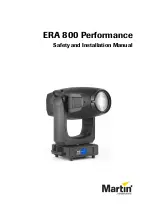
L1V30044656A
RS-AC
Technical Manual
Bus Coupling Unit (BTM)
UP 117C12
5WG1117–2CB12
April 2020 / Page 2
Location and Function of the Display
and Control Elements
A1
Bus Transceiver Interface (BTI) socket for connecting an
application unit with BTI plug
A2
Slots for attaching the Bus Coupling Unit (BTM) to wall
boxes
A3
Slots for mounting application unit with guide and
mounting clamps
A4
Thread for mounting screws (for additional support,
e.g. for securing the application unit against theft)
A5
Type plate
A6
Bus connection block for single core conductors with
Ø 0.6 ... 0.8 mm
Dimension Diagram
Dimensions in mm
B1
NEMA wall box (minimum internal width: 50mm)
B2
Bus coupling unit (BTM)
B3
Bus Transceiver Interface (BTI)
B4
Mounting screw holes
B5
Mounting screws
B6
Design frame
B7
Wall switch
Mounting
General description
The connection to the bus line is established via bus connec-
tion block (screwless plug-in terminals for single core conduc-
tors). The application unit is slipped onto the bus coupling
unit (BTM) via guide and mounting clamps and, depending on
the device type, fastened with screws.
Note
The Bus Coupling Unit (BTM) must be mounted with the Bus
Transceiver Interface (BTI) situated at the bottom. Thus, the
application unit will be oriented properly when slid onto the
BTI. Use bus devices with mounting screws only to achieve a
permanently stable contact at the BTI.
C2.2
C2.1
C2.3
C2
D1
D2
5 mm
D1
D2
Wiring
Slipping off/on bus connection blocks
The bus connection block (C2) is situated on the back of the
bus coupling unit (BTM) (C1).
It consists of two components (C2.1 and C2.2) with four ter-
minal contacts each. Take care not to damage the two test
sockets (C2.3) by accidentally connecting them to the bus ca-
ble or with the screw driver (e.g. when attempting to unplug
the bus connection block).
Slipping off bus connection blocks
- Carefully put the screw driver to the wire insertion slit of
the bus connection block’s grey component (C2.2) and
- pull the bus connection block (C2) from the bus coupling
unit (BTM) (C1).
Note
Don’t try to remove the bus connection block from the bottom
side. There is a risk of shorting-out the device!
Slipping on bus connection blocks
- Slip the bus connection block (C2) onto the guide slot of
the BTM (C1) and
- press the bus connection block (C2) down to the stop.
Connecting and Disconnecting bus cables
Connecting bus cables
- The bus connection block (D1) can be used with single
core conductors Ø 0.6…0.8 mm.
- Remove approx. 5 mm of insulation from the conductor
(D2) and plug it into the bus connection block (D1)
(red = +, black = -)
Disconnecting bus cables
- Unplug the bus connection block (D1) and remove the
bus cable conductor (D2) while simultaneously wiggling
it.
USA
C2
C1
A2
A5
A1
A2
A4
A4
A3
A6
B1
B2
B3
B4
B5
B6
B7
Class 2 power wiring only.
WARNING
The device must be mounted and commissioned by an authorized electrician.
The device must not be opened.
A device suspected faulty should be returned to the local Siemens sales office or distributor.
The prevailing safety rules must be heeded.




















